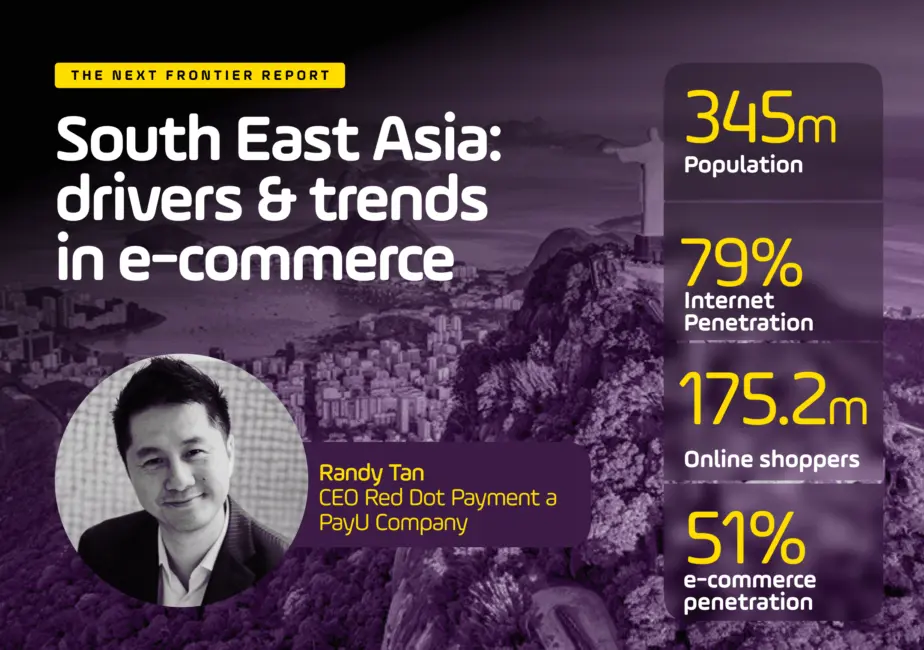Leadership through knowledge
Take a deep dive into the rapidly changing world of e-commerce and fintech.
Visit resource hubWhat opportunities await e-commerce merchants in Southeast Asia? We took a deep dive with Randy Tan, CEO of Red Dot Payment, a PayU company. 28/07/2021

From Singapore and Taiwan to the Philippines, Malaysia, Thailand, Indonesia, and Vietnam, the e-commerce marketplace in Southeast Asia includes a diverse array of developed, developing, and middle-income economies presenting e-commerce merchants with a dazzling array of opportunities for growth in one of the world’s laboratories for digital innovation.
Around half of the population of countries within the Southeast Asian region are under the age of 30 – a favorable demographic mix which helps explain why the region includes several of the world’s fastest-growing internet economies.
How has the pandemic impacted e-commerce and online payments in Southeast Asia? And what are the challenges and opportunities going forward? As part of The Next Frontier, PayU’s recent report on e-commerce opportunities in emerging markets, we reached out to Randy Tan, CEO of Red Dot Payment (a PayU company) to share his thoughts on the present and future of e-commerce in the region.
Scroll below to read Randy’s responses – and be sure to check out our other recent posts on the digital landscape in some of the world’s top emerging e-commerce markets.

As seen the world over, 2020 was a monumental year for e-commerce thanks to the impact of COVID-19. The Southeast Asia (SEA) region saw huge growth across a number of areas, particularly in online food delivery and e-marketplaces, as people shopped online in their millions.
Demographics across the region meant many countries were well placed to meet this acceleration of online behavior. While it does have a large unbanked population (around 50% of the population) there is incredibly high mobile penetration. This meant that in many places, consumers were prepared for the sudden shift to online shopping. Take QR codes: while for many countries QR codes were introduced in 2020 to help reduce physical contact while shopping, in Southeast Asia they were already commonplace.
Across the region there were of course differences in how countries responded to the crisis. In Singapore, for example, the government released mass stimulus packages, totaling over USD $100bn, after its economy was among the hardest hit in Asia thanks to its open and trade-dependent economy. Stimulus packages like these have helped some economies weather the storm and in turn have had a positive impact on e-commerce.

While this naturally varies across the region there are some standout challenges common across all countries.
Firstly, the multitude of payment methods can cause complications for any e-commerce business looking to trade across multiple countries. In markets like Indonesia and Thailand many shoppers are still using cash, and even those who do have cards can be wary about sharing details due to fears around security. Thanks to the high mobile penetration, mobile payment methods are growing in popularity, but each country still has an average of 3-5 additional payment methods which are popular along with the traditional Visa and MasterCard.
Secondly, regulations differ hugely from market to market. In Indonesia for example, as of our most recent knowledge the government requires a payments business to be 51% controlled (voting shares) by local Indonesian partners. Meanwhile, in Thailand it can typically take some time to get a PSP license, with high associated compliance costs. Payment previously in Singapore has always been considered one of the less-regulated markets, but the government there is now moving to introduce more compliance measures, a positive move to ensure payment providers are delivering a compliant service.
While regulation can cause challenges, it also presents opportunities. New regulations that keep up with evolving technology and the requirements of forward-looking merchants can be positive for the market as a whole, ensuring strong standards are kept and the best players can succeed. We welcome regulations that look to safeguard consumers and businesses, while also fostering strong innovation.
Cryptocurrencies also offer a huge opportunity for e-commerce in SEA. While markets like Singapore might be making it hard to fund crypto, many are finding ways around this. In Thailand it’s estimated that 10% of the population already own some form of cryptocurrency, second only to South Africa in global ownership rates. The opportunities cryptocurrency presents to those who are still unbanked across SEA is huge, removing barriers to e-commerce and opening up the market for many.
Buy now pay later (BNPL) is another area to watch in SEA. With low credit card penetration across the region, BNPL has a huge opportunity to provide access to underbanked (or even unbanked) consumers looking to buy online. Companies like Kredivo and Akulaku have both already had 10m+ installations of their apps on Google Play in Indonesia alone.
Some other great examples include Hoolah, founded and based in Singapore, which grew its transaction volume by 1,500% in 2020. Atome, a subsidiary of Advance.ai and an another local BNPL player, reported in November 2020 that its 1,000+ merchants had seen a 20-30% increase in conversions, and as much as a 30% increase in average order size during the pandemic.
Put simply, emerging e-commerce leaders must approach the region with a flexible and open mindset. Southeast Asia is a region of opportunity but it’s also a complicated landscape. From the differing regulations in each country, to the host of ever-changing payment methods, it’s a region that’s constantly evolving. Choosing the right partner is critical – online retailers need a team that knows the local regulations and how best to navigate often daunting looking challenges around compliance.

Get further insights on the e-commerce landscape across Romania and nearly 20 other emerging e-commerce markets where PayU operates around the world.
Combining external sources with local data directly from PayU’s payments platform, our report also provides a window into the payment ecosystem across the countries surveyed, leveraging our experience as a leading payment technology platform offering merchants a single global solution for emerging as well as established markets.
Fill in the form to download our report and learn more about the fast-moving digital landscape in some of the world’s most exciting growth markets for e-commerce.